Introduction
Hello, Talofa, Kumusta, Malo’etau lava, Ki Orana. Welcome to this week's learning.
As you will know by now, medicines affect people differently based on how our bodies affect drugs and how drugs affect drugs. This week, our study of pharmacology focuses on specific populations as we outline the factors to consider when prescribing to children, pregnant people, and the elderly.
Later this week, we have a lot to cover in Anatomy and Physiology as we look at disorders affecting lots of different body systems. We will travel from the muscles, joints, tendons and tissues to the skin, eyes, ears, nose and throat. There will be a lot to take on board, so remember to take regular breaks and participate in all of the activities. Like medicines, you will only get out what you put in (this being effort!).
Welcome back to our pharmacology topic.
Pharmacology recap
Quizzes serve as effective tools for assessing your knowledge and reinforcing learning through immediate feedback. Complete the following 9-question pātaitai (quiz) to have some fun and support your learning!
Note: If you happen to answer a question incorrectly and are unsure why, don't hesitate to discuss it with your tutor for clarification and guidance.
Ināianei, now, let’s now turn our attention to pharmacology in specific populations.
Pregnancy (Haputanga)
The normal physiological changes that occur during pregnancy can alter the way drugs are absorbed, distributed, metabolised and excreted, potentially affecting both the mother and the developing foetus.
As you can see here, the placenta takes on a crucial role in the development of the baby. It not only filters waste and passes on oxygen, but it is a gatekeeper, protecting the baby from toxins, parasites and pathogens. It also distributes hormones.
The effect of drugs on pregnancy
Most drugs cross the placenta from the mother’s bloodstream to the foetus’s and may have harmful effects on the foetus at any stage of pregnancy. Some drugs are only harmful if given at certain stages of the pregnancy.
- During the first trimester, which is when the foetus is developing, drugs may cause permanent birth defects (this is called teratogenicity) in the foetus.
- During the second and third trimesters, drugs may affect the growth and development of the foetus, or they may have toxic effects.
Here, you can see these critical stages of foetal development and the times of greatest vulnerability:
Prescribing medicines
What factors would a prescriber take into consideration when prescribing medicines to a pregnant person?
How many factors can you think of? Challenge yourself to list at least two factors, before clicking on the (+) to compare your answers.
Factors to consider when prescribing in pregnancy:
- Medicines should only be prescribed in pregnancy when the expected benefits to the mother outweigh any potential risks to the mother and foetus.
- The stage of pregnancy influences medication choice.
- Certain medications may be safer during specific trimesters, while others should be avoided altogether.
- The first 12 weeks are crucial in terms of foetal development; therefore, non-essential medicines should be avoided at this stage of pregnancy.
- Drugs given shortly before term or during labour can have adverse effects on labour and delivery.
- The damaging effects of exposure to drugs during pregnancy may not be apparent at birth and may show up later in life.
- Pregnancy can alter drug metabolism and clearance.
- The prescriber may adjust dosages based on physiological changes to maintain therapeutic efficacy while minimising potential harm.
- If possible, medicines should be used at the lowest effective dose for the shortest possible duration.
- The prescriber considers medications with well-established safety profiles in pregnancy whenever possible.
- Drugs with limited data or known risks may be avoided unless necessary for maternal health.
Advice on prescribing in pregnancy is found on the New Zealand Formulary (NZF) website. It provides information that is specific to a drug and gives an indication of the risks involved and what to expect. Some of this information comes from Wolters Kluwer Health's renowned resource called Drugs in Pregnancy and Lactation.
Journal posts
This is a two-part journal post activity! Follow the instructions to create two separate journal posts for these two types of medication and whether they can be used for pregnant people.
Journal post #1: Analgesics in pregnancy
- Create a new journal post titled ‘Analgesics in Pregnancy’.
- Use the NZF to answer the following questions about analgesics in pregnancy.
- Hint: Make sure you click on the down arrow next to the words “pregnancy summary” to read all the available guidance.
- Publish your post to ‘All course users’.
- Save the permalink to your Index of Journal Posts. This will allow you to check for feedback and use your hard work for future reference.
Questions
- Can paracetamol be used in pregnancy?
- If so, under what conditions?
- If not, why not?
- Can ibuprofen be used in pregnancy?
- If so, under what conditions?
- If not, why not?
Journal post #2: Isotretinoin in pregnancy
Isotretinoin is a drug that is prescribed for acne. It is a drug you will be familiar with from your learning in anatomy and physiology.
- Create a journal post with the title, ‘Isotretinoin in Pregnancy’.
- Conduct rangahau (research) and post your answers to the following:
- Explain why this drug is contraindicated in pregnancy.
- Outline what advice about contraception and conception is given to patients before it is prescribed.
- Publish the post to ‘All course users’.
- Save the permalink to your Index of Journal Posts.
Breastfeeding (Whakangote)
Most drugs cross into the breast milk, but often at concentrations too low to cause harm. It is still best to avoid taking drugs while breastfeeding. As previously mentioned, information on specific drugs during pregnancy and lactation (breastfeeding) can be found on the NZF.
Taking drugs during breastfeeding
If it is necessary to take drugs during the period of breastfeeding, it is safest to feed the baby just before taking the dose, when blood levels in the mother will be lowest.
If the drug is unsafe for the baby, expressing and discarding breast milk during treatment helps maintain milk production until breastfeeding can resume safely.
Infants and children (Kohungahunga me nga tamariki)
Pharmacological management in infants and children requires careful consideration of their unique physiological characteristics and developmental stages.
Prescribing medicines
Factors to consider when prescribing for infants and children include:
- Age
- Physiology and dosage
- Developmental changes
Haere tonu, continue on to read more about each factor.
Age-related variations in drug metabolism and elimination
- Infants and children have different metabolic rates compared to adults, which can affect how drugs are processed and eliminated from their bodies.
Physiology and dosage
- Infants and children have immature organ systems, such as the liver and kidneys, that are still developing, which may affect drug metabolism and excretion.
- Factors like body composition and surface area may influence drug distribution and dosing.
- Babies and young children are often dosed by weight rather than a standardised dose.
- Low therapeutic index drugs need to be carefully monitored, especially in neonates (newborns).
- Children from the age of 12 are usually treated as adults.
Developmental changes
- As children grow and develop, their pharmacokinetic and pharmacodynamic profiles change.
- This can impact drug efficacy and safety over time, requiring adjustments in dosing and monitoring.
There is a separate New Zealand Formulary for children, which can be found here: nzfchildren.org.nz.
It’s a good idea to bookmark this webpage on your browser or note it down for future reference.
Elderly (Kaumatua)

Pharmacological management of patients in the older adult age range requires several factors due to age-related changes in physiology and potential comorbidities.
Prescribing medicines
Key considerations when prescribing include:
- Liver function
- Renal function
- Drug sensitivity
- Comorbidities and polypharmacy
Again, let’s look at these in more detail.
Liver function
- Aging affects liver enzymes responsible for drug metabolism, leading to slower metabolism and prolonged drug half-lives.
Renal function
- Kidney function declines with age, resulting in decreased drug clearance and increased risk of drug accumulation and toxicity.
Drug sensitivity
- Older adults may be more sensitive to certain medications due to changes in drug distribution and receptor sensitivity.
- They are more susceptible to adverse drug reactions due to age-related changes in pharmacokinetics and pharmacodynamics, as well as increased sensitivity to medications such as those with sedating properties.
Comorbidities and polypharmacy
- Aging is associated with a higher prevalence of comorbidities (more than one disease), which may necessitate the use of multiple medications (polypharmacy).
- This increases the complexity of drug therapy and the risk of drug interactions and adverse effects.
Summary
Summarise your learning of this section in the following activity.
Self-directed learning activity
Activity 1
Read and make your own notes from this Bpacnz article: Community pharmacy guide on medicine safety in pregnancy.
As an optional extra, feel free to use all or some of the following prompts. These are designed to guide your note-taking and help you understand how to apply this information in your role as a pharmacy technician.
Optional prompts
- Summarise the key considerations highlighted in the article for assessing the risks and benefits of using medications during pregnancy.
- Outline the recommended first-line interventions and lifestyle advice for pregnant women before considering over-the-counter (OTC) medications.
- Provide a detailed overview of recommended non-pharmacological and OTC treatment options for common conditions during pregnancy, such as pain relief, head lice treatments, conjunctivitis, insect bites, hay fever, coughs, and colds.
- Summarise the examples of prescription medications mentioned in the article that require extra vigilance during pregnancy.
- Outline the role of community pharmacists in ensuring awareness and communication regarding pregnancy with prescribers and patients.
Activity 2
- Explore the New Zealand Formulary (NZF) for children.
- Read and take notes from this webpage on the general principles for the safe and successful prescribing of medicines for children: Medicines for children - general principles.
- Again, consider the following optional prompts if you would like some inspiration to aid your note-taking and comprehension.
Optional prompts
- Reflect on the key factors highlighted in the article that differentiate the prescription and administration of medicines to children compared to adults.
- Discuss the challenges mentioned in the article that contribute to poor adherence in paediatric patients.
- Reflect on strategies proposed in the article to improve adherence, including the importance of concordance and effective communication with children and their carers.
- How can healthcare professionals, including pharmacists, minimise the risks associated with medication handling for paediatric patients?
- How can healthcare professionals strike a balance between involving children in medication decisions and considering their age, understanding, and personal circumstances?
- How can pharmacists contribute to effective communication between healthcare professionals, children, and their carers regarding medication use?
That wraps up this pharmacology session. Ka pai temahi, good work.
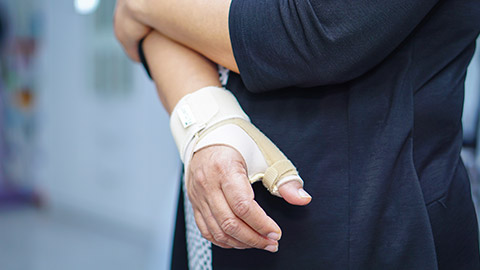
In this week of Anatomy and Physiology, we look at a musculoskeletal disorder before moving on to disorders of the integumentary system, eye and ENT. The content will continue to build on what you already know.
There is a lot to cover, so get yourself ready and hoake tātou! Let’s go!
Occupational Overuse Syndrome (OOS)
Occupational Overuse Syndrome, formally known as RSI (Repetitive Strain Injury), is an umbrella term for a range of conditions that cause discomfort or persistent pain in muscles, joints, tendons, nerves and soft tissues.
Causes
Occupational Overuse Syndrome can have various causes, typically associated with repetitive or prolonged activities in the workplace.
Some common causes include the following:
- Repetitive tasks or movements, such as typing, using a mouse, or assembly line work, can strain specific muscles or joints over time.
- Inadequate workspace setup, improper chair or desk height, and lack of ergonomic tools.
- Using excessive force or exerting too much pressure during tasks can lead to strain on muscles and joints.
- Maintaining awkward or uncomfortable positions for extended periods, especially if the body is not properly supported.
- Prolonged exposure to vibrating tools or machinery can contribute to muscle and joint fatigue.
- Inadequate breaks or insufficient recovery time between repetitive tasks.
- Personal factors such as overall health, fitness levels, and pre-existing medical conditions can also influence the likelihood of developing OOS.
Treatments for OOS
Once a diagnosis of OOS has been made and the specific OOS condition has been identified, appropriate treatment will be recommended.
This may involve referral to an occupational or musculoskeletal specialist and may involve input from healthcare professionals such as occupational therapists and physiotherapists.
As this is a condition that may even affect you in your career, challenge yourself to consider if there are any treatments that you would suggest or already do to mitigate OOS. When you’re ready, expand the label to compare your answers.
- Rest from activities
- Changing work practices
- Postural correction
- Physiotherapy
- Exercise and stretching
- Relaxation exercises
- Pain-relieving and anti-inflammatory medications.
Journal post
MS Disorders: OOS
- Create a new journal post titled ‘MS Disorders: OOS’.
- Carry out your own rangahau (research) and record your findings to the following:
- Describe the non-pharmaceutical actions or treatments for OOS.
- Describe the over-the-counter products that can be used to help alleviate the symptoms of OOS.
- Publish your post to ‘All course users’.
- Save the permalink to your Index of Journal Posts.
Integumentary system
Previously, we looked at the structure and function of the integumentary system and the disorders of acne, dermatitis and eczema. Building on this knowledge, we will continue to investigate our investigation of integumentary disorders, this week focusing on seborrhoeic dermatitis and acne.
Seborrhoeic dermatitis
Seborrhoeic dermatitis is a type of dermatitis caused by a yeast or fungus. It can cause dandruff, a common condition where the scalp is itchy and skin flakes without any signs of inflammation.
Journal post
Seborrhoeic dermatitis
In this activity, you will jump right into action to learn more about this disorder.
To prepare yourself, check out these useful resources about seborrhoeic dermatitis first and then step into your pharmacy technician shoes to discuss this disorder with 35-year-old Molly and her six-week-old baby called Noah.
Resources
- DermNet: Seborrhoeic Dermatitis
- National Eczema Society (UK): Seborrhoeic dermatitis in adults
- National Eczema Society (UK): Seborrhoeic dermatitis & cradle cap in infants
- Healthify: Dermatitis
Instructions
- Complete the following Documentation tool activity.
- Download and save the completed activity.
- Create a new journal post titled 'Seborrhoeic dermatitis'.
- Upload the completed activity to your post and publish it to 'All course users'.
- Save the permalink to your Index of Journal Posts.
Treatments
Treatment typically involves a combination of self-care measures and medications. Pharmacological treatments include:
Topical Antifungal Agents
- Often prescribed in the form of medicated shampoos, creams, or lotions containing antifungal agents such as ketoconazole, ciclopirox, selenium sulfide, zinc pyrithione, coal tar, and salicylic acid.
- They help reduce inflammation and control the overgrowth of yeast on the skin.
- Example: Ketoconazole 1% Shampoo (Nizoral, Sebizole).
- It is applied as a shampoo to wet hair. Once applied, it is left on the hair for 3-5 minutes before rinsing. It is used twice weekly for at least a month.
Topical steroids
- Corticosteroid creams or lotions may be prescribed to reduce inflammation, which works by reducing the inflammation in the affected area to reduce the redness, swelling, and itchiness of the skin.
- Example: Betamethasone Valerate Scalp Lotion 0.1% (Betnovate lotion).
- This lotion is applied sparingly to the affected areas of the scalp, once or twice daily, for no more than four weeks at a time.
Acne vulgaris
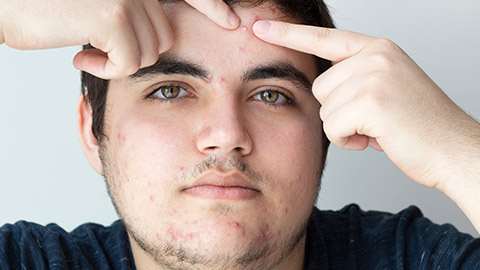
In your previous learning, you carried out an activity identifying the features of acne.
Optional refresher
If you’re confident in identifying the types, symptoms, treatments, and medicines for acne and dermatitis, haere tonu, continue on. Otherwise, you may want to retry this activity to revise what you have learned.
Causes of acne
Acne is a common skin condition that mostly affects young adults in puberty. It is caused by inflammation of the sebaceous glands of the face and sometimes the chest and the back.
Hormonal changes related to menstruation or pregnancy can also cause or contribute to acne. Environmental irritants such as pollution, intense heat, humidity, or cold can also be contributing factors.
During puberty, the production of male sex hormones (androgens) increases in both sexes, which stimulates the sebaceous glands to produce more sebum. In some people, the sebaceous glands are extremely sensitive to androgens. This increased sebum production narrows the openings of the sebaceous glands, and the sebum builds up in the pore.
Sebum and dead epithelial cells block the pore, forming a plug called a comedome – a whitehead. The comedome oxidises on contact with air and turns black – a blackhead. Often, there is involvement of a common skin bacteria that lives on the fatty acids found in sebum. The bacteria produce waste products and fatty acids that irritate and inflame the sebaceous glands.
Symptoms
The first symptoms are small, tender, red spots that later turn into pimples containing degraded fatty acids. The inflammation disappears over a few days or weeks, depending on the severity. Severe acne can cause scars, so an early, effective treatment is important.
Acne or pimple formation
Treatments for acne
There are various treatments for acne, depending on the severity. Mild acne can be treated with OTC products, but more severe forms require medical attention for assessment and treatment with prescription medications.
Treatments may include:
Topical antiseptics
- Kills or inhibits the growth of bacteria on the skin's surface, helping to reduce the number of acne-causing bacteria and prevent infection.
Keratolytics
- Helps to exfoliate (remove dead skin cells) the outer layer of the skin, unclog pores, and remove dead skin cells, which can contribute to the formation of acne lesions.
Keratolytics with topical antibiotics
- This combined treatment can help to address both the clogging of pores and the bacterial component of acne, reducing inflammation and preventing new acne lesions from forming.
Keratolytics with topical antibiotics and topical anti-inflammatory
- This combination targets multiple aspects of acne formation, including pore blockage, bacterial growth, and inflammation, providing comprehensive treatment for acne.
Topical retinoids
- Help to unclog pores, reduce inflammation, and promote the turnover of skin cells, leading to smoother and clearer skin.
Oral antibiotics
- Prescribed to target the bacteria involved in acne formation, reducing inflammation and preventing the spread of infection.
Oral isotretinoin
- An oral medication that is reserved for severe cases of acne that have not responded to other treatments.
- It works by reducing the size of the sebaceous glands in the skin and the production of sebum (skin oil).
- It also inhibits the growth of bacteria and helps prevent the clogging of hair follicles.
Journal post
Acne Treatments
In this tūmahi (activity), you will use your trusted resources to rangahau (research) treatments for each of the treatments listed above, with a focus on oral isotretinoin. You will then share your findings in a journal post.
- Complete the following Documentation tool activity.
- Download and save the completed activity.
- Create a new journal post titled ‘Acne Treatments’.
- Upload the completed activity to the journal post and publish the post to ‘All course users.’
- Save the permalink to your Index of Journal Posts. Your tutor may review your answers and provide feedback, making it easier to check back!
The eye (karu or whatu)
In previous content, we looked at the eye (pun intended). The disorders we discussed were conjunctivitis and dry eye. Let’s shift our focus now to another eye disorder, Glaucoma.
Glaucoma
Glaucoma is a condition where there is damage to the optic nerve, often due to increased pressure within the eye. This elevated intraocular (inside the eye) pressure can result from various factors, including impaired drainage of aqueous humour, a fluid that normally flows in and out of the eye.
The increased pressure compresses and damages the optic nerve, leading to vision loss, initially in the peripheral field and eventually progressing to central vision if left untreated.
Watch: Glaucoma […] (3:05 minutes)
Watch this animated video to see how issues with the normal functioning of the eye result in damage to the optic nerve and vision.
Types of glaucoma
As you heard in the video, there are two main types of glaucoma:
- Open-angle: This occurs when the drainage angle within the eye remains open, but the drainage channels become clogged over time.
- Angle-closure: This occurs when the drainage angle of the eye becomes blocked, leading to a sudden increase in eye pressure.
Symptoms
Glaucoma often develops slowly and without noticeable symptoms until the disease has progressed significantly. Symptoms may include:
- Eye pain or pressure
- Headaches
- Rainbow-coloured halos around lights
- Low vision, blurred vision, narrowed vision (tunnel vision) or blind spots
- Nausea and vomiting
- Red eyes.
Closed-angle glaucoma has more severe symptoms that tend to come on suddenly.
People at higher risk of developing glaucoma include people who:
- Are older than 40 years
- Have a family history of glaucoma
- Are either short-sighted or long-sighted
- Have a history of migraine or Raynaud syndrome
- Use cortisone or steroids
- Have a previous eye injury.
Treatment
Treatment can’t cure glaucoma, but it can slow down the progression. Treatments for glaucoma that prevent further damage to the optic nerve are ones that lower the intraocular pressure. The most common way to do this is through administration of medicated eye drops.
Here are two different types of eye drops that can be used.
Prostaglandin analogues
- These work by mimicking the action of naturally occurring prostaglandins in the eye, leading to relaxation and widening of the eye's drainage channels (known as the trabecular meshwork).
- This allows for better outflow of aqueous humour from the eye, effectively lowering intraocular pressure.
- Example: Latanoprost (Teva®).
Beta-blockers
- Beta-blockers work by blocking the action of beta-adrenergic receptors found in the ciliary body of the eye.
- The ciliary body is responsible for producing aqueous humour.
- By blocking these receptors, beta-blockers reduce the activity of the ciliary body, leading to a decrease in aqueous humour production with a subsequent reduction in intraocular pressure.
- Example: Timolol (Arrow-Timolol®).
Journal post
Glaucoma: Latanoprost eye drops
Rangahau time! Research time! You know what to do: find out the answers to the following and record your findings in your journal.
- Create a new journal post with the title ‘Glaucoma: Latanoprost eye drops’.
- Answer the following questions.
- Publish your post to ‘All course users’.
- Save the permalink to your Index of Journal Posts for safekeeping.
Questions
- What type of glaucoma is latanoprost used for?
- What instructions for use would you give the patient?
- What are the instructions for use for patients who wear contact lenses?
- What are the instructions for use for patients who are currently using other ophthalmic medications?
- List the potential side effects of latanoprost eye drops.
Ear, nose and throat (ENT) disorders
Earlier in your learning, we discussed the parts of the body that make up the ENT speciality and lightly touched on a few conditions that affect these body parts. This week, we will focus on otitis media, hay fever, xerostomia and strep throat.
Otitis media (Pokenga taringa)
As we briefly touched on otitis media, answer the following two questions to check your memory. As some of the information is new, you may need to make some educated guesses!
Otitis media is an inflammation or infection of the middle ear, usually caused by bacteria or viruses. It typically occurs when the eustachian tube, which connects the middle ear to the back of the throat, becomes blocked or swollen, leading to fluid buildup behind the eardrum. This buildup can create an environment conducive to bacterial or viral growth, resulting in infection.
Symptoms
Symptoms can include:
- Ear pain that can be mild to severe pain, particularly when lying down or chewing.
- A feeling of fullness or pressure in the ear.
- Temporary hearing loss or muffled hearing.
- Fluid or pus draining from the affected ear, especially if the eardrum has ruptured.
- In some cases, otitis media may be accompanied by fever, particularly in children.
- Balance and coordination problems with associated nausea.
- Severe cases can lead to complications such as hearing loss, glue ear or the spread of infection to nearby structures.
Treatments
Treatments for otitis media include the following:
Antibiotics
- Antibiotics eliminate the bacteria responsible for the infection and help prevent potential complications, such as the spread of the infection to nearby structures like the mastoid bone or the development of chronic otitis media.
- As the site of infection is behind the ear drum, antibiotic ear drops will not be effective.
- Therefore, the route of administration is oral for its systemic effect and ability to reach the site of infection.
Analgesics
- Panadol or ibuprofen may be recommended to relieve pain and reduce fever.
Decongestants or antihistamines
- Decongestants or antihistamines may be prescribed to help alleviate nasal congestion and promote drainage of fluid from the middle ear.
Antiemetics
- Where nausea is severe or persistent, antiemetics may be prescribed to provide symptomatic relief from nausea.
Journal post
Otitis Media Treatment
Step into the shoes of a pharmacy technician to support a young patient in this tūmahi (activity). You can refer to your trusted resources to aid you.
- Complete the following Documentation tool activity.
- Download and save the completed activity.
- Create a new journal post titled ‘Otitis Media Treatment’.
- Upload the completed activity to the journal post and publish the post to ‘All course users.’
- Save the permalink to your Index of Journal Posts so that you can easily check back for tutor feedback.
Hay fever (Mate hei)

Hay fever is a disorder that affects the upper respiratory tract, primarily the nose. As we have already explored hay fever earlier in this programme, you will be familiar with some of the symptoms, causes and treatments.
Forum activity
To refresh your current knowledge, take a moment now to answer the questions in the following scenario.
Scenario
- In the forum: Hay Fever Scenario
- respond to the pharmacy assistant’s questions and
- include a description of the signs and symptoms of hay fever.
- Once you’ve posted your answer, have a read of your peers’ responses to see if there is anything different that they have included.
Treatments
Treatments for hay fever include OTC products and prescription medicines. These include:
- Oral antihistamines
- Topical antihistamines (nasal and ocular)
- Topical corticosteroids (nasal)
- Decongestants (nasal and oral)
- Medicated and non-medicated eye drops
- Saline nasal products
- Natural/herbal products.
Xerostomia
Xerostomia, commonly known as dry mouth, is a disorder of the mouth characterised by a lack of saliva production.
Causes
Xerostomia can be caused by various factors, including medications, radiation therapy, autoimmune diseases, and dehydration.
Symptoms
Symptoms of xerostomia may include:
- persistent dryness in the mouth
- difficulty swallowing
- altered taste sensation.
Complications
Complications associated with untreated xerostomia may include:
- Tooth decay
- Burning sensation in the mouth
- Oral infections
- Gum disease
- Thick or stringy saliva
- A dry or sore tongue
- Bad breath (halitosis)
- Difficulty speaking and swallowing.
Treatments
Management of xerostomia typically involves addressing the underlying cause, maintaining good oral hygiene, and using artificial saliva substitutes or medications to stimulate saliva production.
Non-Pharmacological treatments
Patients can do the following to help address or mitigate some of the symptoms and causes:
- Have good daily oral hygiene.
- Attend regular dental checkups.
- Drink frequent sips of water or suck ice cubes to moisten their mouth.
- Suck sugar-free sweets or chew sugar-free gum to stimulate saliva.
- Avoid alcohol, caffeine and smoking.
- Use OTC saliva substitutes or oral moisturisers.
- Use saliva substitutes that are extemporaneously prepared (compounded in the pharmacy).
- Apply lip balm or lip moisturiser to prevent drying and cracking.
Pharmacological treatments
Here are some examples of OTC oral moisturisers: Xerostom® products.
These products come in various forms, such as mouth sprays, lozenges, gels, or mouth rinses. They act as oral wetting agents and lubricants to alleviate symptoms of dry mouth.
| Mouth spray | Mouthwash | Pastilles | Saliva substitute gel | Toothpaste |
|---|---|---|---|---|
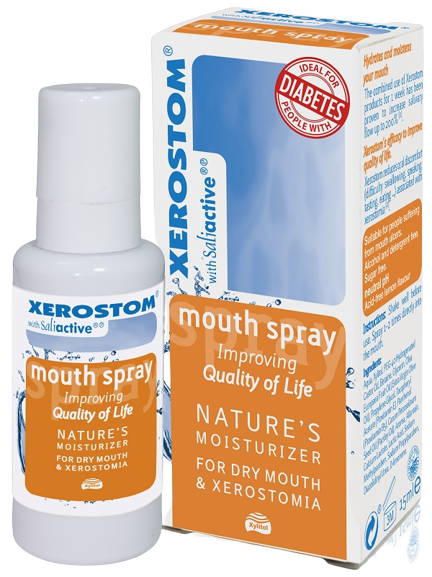 |
 |
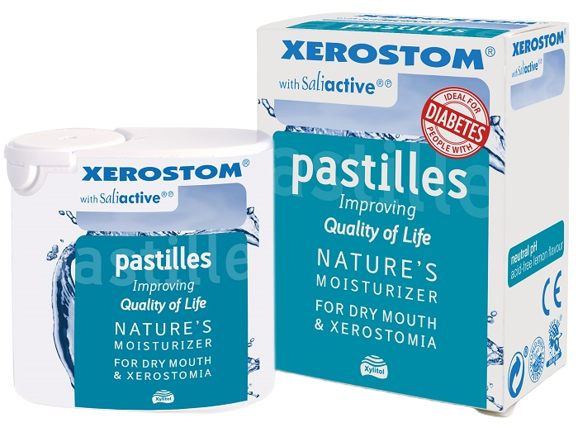 |
 |
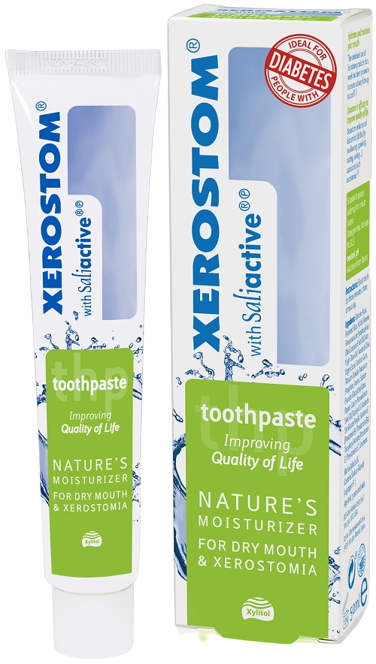 |
| Images from: Pharmacy Direct. | ||||
Strep throat
Strep throat is a bacterial infection caused by Group A Streptococcus bacteria. It primarily affects the throat and tonsils. It is common in the winter months and in crowded living conditions and mostly affects people aged five to 15.
Some people are carriers of Group A Streptococcus. These people have the bacteria in their throats all the time without becoming ill, but they can cause illness in others by spreading the bacteria.
It is believed that up to 15 per cent of school children are asymptomatic carriers. It is spread through coughing, sneezing, and sharing cups and utensils and has an incubation period of between two days to one week.
Symptoms
- Sore throat
- Difficulty swallowing
- Fever
- Red and swollen tonsils that may be covered in pus
- Swollen lymph nodes in the neck
- Headache
- Fatigue
- Nausea or vomiting
Complications
If left untreated, Group A Streptococci infections can lead to the following serious complications.
For each complication listed, challenge yourself to write down the body parts that it affects and its symptoms before selecting the (+) symbol to expand the label.
- An inflammatory condition that can affect the heart, joints, skin, and brain.
- It typically develops two to four weeks after a strep throat infection and can lead to long-term heart damage (rheumatic heart disease).
- People at higher risk of developing this complication are those who have had rheumatic fever before or live with someone who has, or if they have two or more of the following:
- Are of Māori or Pasifika ethnicity
- Aged 3–35 years
- Live in poorer or crowded living conditions.
- This occurs when toxins produced by strep bacteria cause a rash that feels like sandpaper and looks like sunburn.
- Other symptoms may include a red, sore throat, fever, headache, and swollen glands.
- This is a highly contagious skin infection characterised by red sores or blisters that can break open and form crusts.
- It can occur when the bacteria from strep throat spread to the skin through scratching or close contact with an infected person.
- This is a kidney disease that can develop after a strep infection, particularly strep throat or impetigo.
- It can cause blood in the urine, swelling, and high blood pressure.
Treatments
Treatments for strep throat include the following:
- Antibiotics such as penicillin or amoxicillin kill the bacteria causing the infection.
- These are normally given for ten days.
- OTC pain relievers such as paracetamol or ibuprofen may also be recommended to alleviate symptoms like fever and sore throat.
- Throat spray or pain-relief (anaesthetic) lozenges.
Self-care measures
- Eating soft foods that are gentle on the throat.
- Ensuring adequate nutrition.
- Gargling with warm salt water. This can soothe a sore throat, help eliminate bacteria and lessen inflammation.
Self-directed learning activities
Topical Hay Fever Treatments
We round up this week with some final rangahau (research) into three different hay fever treatments.
- Complete the following Documentation tool activity.
- Download and save the completed activity.
- Create a new journal post titled ‘Topical Hay Fever Treatments’.
- Upload the completed activity to the post and publish it to ‘All course users’.
- Save the permalink to your Index of Journal Posts.
- Give yourself a pat on the back for completing the final activity for this week!
Ko koe a runga, you are awesome. You made it to the end of this session. Your SDL activities for this week will enhance your knowledge of hay fever treatments, so make sure to complete them!
